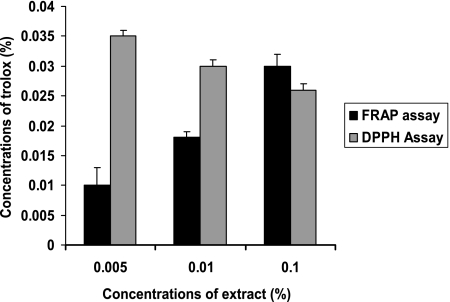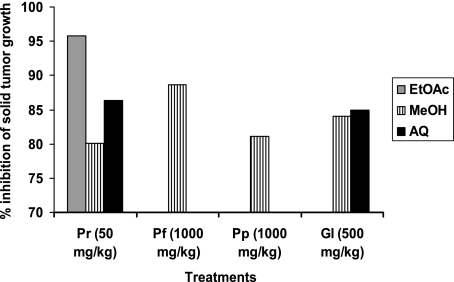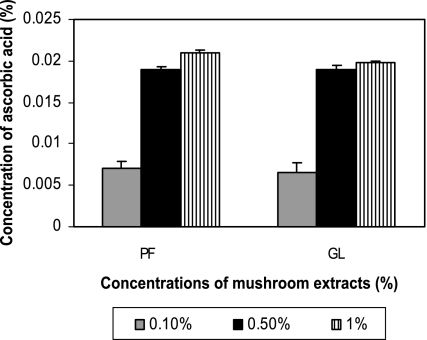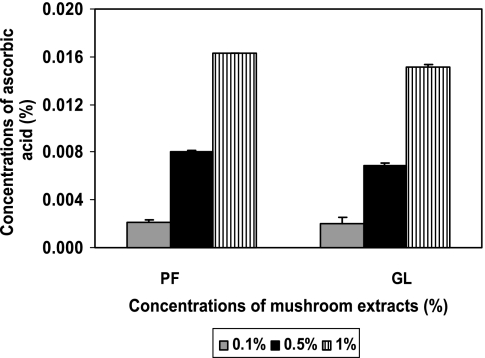Abstract
Medicinal mushrooms occurring in South India namely Ganoderma lucidum, Phellinus rimosus, Pleurotus florida and Pleurotus pulmonaris possessed profound antioxidant and antitumor activities. This indicated that these mushrooms would be valuable sources of antioxidant and antitumor compounds. Investigations also revealed that they had significant antimutagenic and anticarcinogenic activities. Thus, Indian medicinal mushrooms are potential sources of antioxidant and anticancer compounds. However, intensive and extensive investigations are needed to exploit their valuable therapeutic use.
Keywords: antioxidant, antitumor, medicinal mushroom
Introduction
Many clinically used drugs such as aspirin, digitoxin, progesterone, cortisone, morphine, vincristine, vinblastine, taxol and several others are derived directly or indirectly from higher plants. Clinically important and well recognized drugs of fungal origin are penicillin, griseofulvin, ergot alkaloids and cyclosporine. Among the large resources of fungi, higher Basidiomycetes especially mushrooms are unlimited sources of therapeutically useful biologically active agents. There are approximately 700 species of higher Basidiomycetes that have been found to possess significant pharmacological activities [1, 2]. Modern scientific studies on medicinal mushrooms have expanded exponentially during the last two decades not only in Japan, Korea and China but also in USA and scientific explanation to show mushrooms derived compounds function in human system are increasingly being established [3]. Medicinal mushrooms have an established history of use in traditional oriental medicine. Many traditionally used mushrooms from genera, Auricularia, Flammulina, Ganoderma, Grifola, Lentinus, Trametes (Coriolus) and Tremella have been demonstrated to possess significant medicinal properties [2].
Great threat to human life by neoplastic diseases continues to increase and thus the pursuit for anti-tumor drugs takes a compelling urgency. Attempts have been made in many parts of the world to explore the use of mushrooms and their metabolites for the treatment of a variety of human ailments [4]. The most significant medicinal effect of mushrooms and their metabolites that have attracted the attention of the public is their antitumor property. Lucas and his collaborators first demonstrated the antitumor activity of the higher Basidiomycetes in 1957 [5].
The significant pharmacological effects and physiological properties of mushrooms are bioregulation (immune enhancement), maintenance of homeostasis and regulation of biorhythm, cure of various diseases and prevention and improvement from life threatening diseases such as cancer, cerebral stroke and heart diseases. Mushrooms are also known to have effective substances for antifungal, anti-inflammatory, antitumor, antiviral, antibacterial, hepatoprotective, antidiabetic, hypolipedemic, antithrombotic and hypotensive activities [6].
The oxidative properties of oxygen play a vital role in diverse biological functions such as utilization of nutrients, electron transport to produce ATP and the removal of xenobiotics [7]. While oxygen is essential for life, it also can provoke damaging oxidative events within cells. Oxygen, by it’s transformation to more reactive forms i.e., superoxide radical (O2−·), hydroxyl radical (·OH) and hydrogen peroxide (H2O2) can nick DNA, can damage essential enzymes and structural proteins and can also provoke uncontrolled chain reactions, such as lipid peroxidation or autooxidation reactions (e.g. polymerization of catecholamines) [8, 9].
Oxygen derived free radicals are generated during the oxidative metabolism and energy production in the body and are involved in the regulation of signal transduction and gene expression, activation of receptors and nuclear transcription factors. Overwhelming evidences indicate that oxidative stress can lead to cell and tissue injury. In most of the cases free radicals are secondary to the diseases but in some instances they are causal. In addition to reactive oxygen species (ROS), researches on reactive nitrogen species (RNS) are gathering momentum, an area of enormous importance in biology and medicine. Current hypothesis favors the idea that lowering oxidative stress can be a health benefit.
The antioxidant status in human reflects the dynamic balance between the antioxidant defence and prooxidant conditions and this has been suggested as a useful tool in estimating the risk of oxidative damage [10]. ROS have been implicated in the pathophysiology of various clinical disorders, including ischemia, reperfusion injury, myocardial infarction, rheumatoid arthritis, neurodegenerative, atherosclerosis, acute hypertension, hemorrhagic shock and diabetes mellitus [7].
Selected Examples of Indian Medicinal Mushrooms with Antioxidant and Antitumor Activities
Over the last 2–3 decades scientific studies carried out in Japan, China, Korea and more recently in USA have increasingly demonstrated the potent and unique health enhancing properties of compounds and extracts of range of medicinal mushrooms. However, only a limited number of mushrooms available in India till now are investigated for their pharmacological properties. Nevertheless, recent investigations in our laboratory revealed that a number of medicinal mushrooms occurring in South India possessed promising antioxidant and anticancer properties.
Phellinus rimosus
Phellinus is a large and widely distributed genus of the family Hymenochetaceae. (Donk) under the class, Basidiomycetes. The species are mostly confined to the plains/tropical forests. Environmental factors such as temperature, humidity, light and host trees are very important for development of basidiocarps. The dominant and most frequently found species are Phellinus (P. senex), P. rimosus, P. badius, P. fastuosus, P. adamantinus, P. caryophylli and P. durrissimus [11]. About 18 species are found to occur in Kerala, most of them are wood inhabiting [12]. P. rimosus (Berk) Pilat is found growing on jackfruit tree trunks in Kerala. In Kerala, this mushroom is commonly found on living Moraceae members.
In Chinese medicine hot water extract of the fruiting bodies of Phellinus species have been used for an extensive range of ailments and it is believed to work as a miracle drug refreshing the human body and prolong longevity [13]. Recent studies have compared hot water extract of Phellinus with other anticancer mushrooms. The Phellinus extract showed the strongest evidence of tumor proliferation suppression [14].
Ethyl acetate, methanol and aqueous extracts of the P. rimosus were effective to scavenge O2−· generated from the photoillumination of riboflavin, ·OH generated from Fenton’s reaction, nitric oxide radical released from aqueous solution of sodium nitroprusside in a dose dependent manner [15–17]. The extracts inhibited dose dependently ferrous ion induced lipid peroxidation in the rat whole liver homogenate. The effective concentrations required to scavenge 50% of generated radicals (IC50) are given in Table 1. Methanol extract of P. rimosus effectively reduced ferric ion in FRAP assay and scavenged DPPH radicals (Fig. 1).
Table 1.
In vitro antioxidant activity of ethyl acetate (EtOAC), methanol (MeOH) and aqueous (AQ) extracts of P. rimosus (Pr), G. lucidum (Gl), P. florida (Pf), and P. pulmonarius (Pp).
| Extracts | IC50 (µg/ml) |
|||
|---|---|---|---|---|
| Super oxide scavenging | Nitric oxide scavenging | Hydroxyl radical scavenging | Lipid peroxidation inhibiting | |
| EtOAc | 22.0 ± 1.0 | 438.0 ± 21.6 | 68.0 ± 4.1 | 162 ± 7.0 |
| (Pr) | (Pr) | (Pr) | (Pr) | |
| — | — | 530.0 ± 29.4 | 496.0 ± 4.7 | |
| (Pf) | (Pf) | (Pf) | (Pf) | |
| MeOH | 25.3 ± 1.2 | 126.7 ± 12.6 | 93.0 ± 10.3 | 282 ± 12.8 |
| (Pr) | (Pr) | (Pr) | (Pr) | |
| 152.5 ± 2.5 | — | 560.0 ± 0.1 | 873.5 ± 7.2 | |
| (Gl) | (Gl) | (Gl) | (Gl) | |
| — | — | 476.7 ± 24.6 | 960.0 ± 10.0 | |
| (Pp) | (Pp) | (Pp) | (Pp) | |
| — | — | 263.3 ± 24.9 | 320.0 ± 10.0 | |
| (Pf) | (Pf) | (Pf) | (Pf) | |
| AQ | 126.0 ± 5.1 | 31.0 ± 4.5 | 71.0 ± 4.7 | 318 ± 2.4 |
| (Pr) | (Pr) | (Pr) | (Pr) | |
| 475.0 ± 25.0 | — | 140.0 ± 2.0 | — | |
| (Gl) | (Gl) | (Gl) | (Gl) | |
| — | — | 263.3 ± 24.9 | — | |
| (Pf) | (Pf) | (Pf) | (Pf) | |
Values are mean ± SD, n = 3. Names of mushrooms included in the parenthesis.
Fig. 1.
Ferric ion reducing and DPPH radical scavenging activities of methanol extract of P. rimosus. Values are mean ± SD, (n = 4). Activities are expressed in equivalent concentrations of trolox.
All the three extracts when tested for antitumor activity were found to inhibit the Dalton’s Lymphoma Ascites (DLA) cell line induced solid tumor in mice and Ehrlich’s Ascites Carcinoma (EAC) cell line induced ascites tumor in mice [18]. The antitumor effect was found to be higher for the ethyl acetate extract than other extracts (Fig. 2). The results indicated that the extracts of P. rimosus possessed profound antitumor activity.
Fig. 2.
Antitumor activity of ethyl acetate (EtOAc), methanol (MeOH) and aqueous (AQ) extracts of P. rimosus (Pr), G. lucidum (Gl), P. florida (Pf) and P. pulmonaris (Pp) against EAC induced solid tumor in mice.
Ganoderma lucidum
Ganoderma lucidum (G. lucidum) and related species have the longest historical usage for medicinal properties dating back at least four thousand years [19]. In Japan it is called Reishi and in China and Korea it is variously called Ling Chu and Ling Zhi (Mushroom of immortality). Traditionally it has been used widely in the treatment of hepatopathy, chronic hepatitis, nephritis, hypertension, arthritis, insomnia, bronchitis, asthma and gastric ulcer. Scientific studies have confirmed that the substances extracted from the mushrooms can reduce blood pressure, blood cholesterol and blood sugar level as well as inhibition of platelet aggregation.
Ganoderma species are famous tonic in Chinese medicines. They are widely distributed in India on tree trunks. Ganoderma belongs to the polyporaceae family of Basidiomycota. Generally Ganoderma species are described as beneficial to all viscera and non-toxic [20]. For 4000 years G. lucidum has been used as a part of Chinese and Japanese medicine especially for the treatment of most of the human ailments including chronic hepatitis, nephritis, hepatopathy, neurasthenia, arthritis, bronchitis, asthma, gastric ulcer etc.
Extracts from fruiting bodies and mycelia of G. lucidum occurring in South India were found to possess in vitro antioxidant activity [21, 22] and antimutagenic activities [22] The results of the antioxidant assays showed that ethyl acetate, methanol and aqueous extract of G. lucidum effectively scavenged the O2−· and ·OH radicals (Table 1). However the aqueous extract was not effective to inhibit the ferrous ion induced lipid peroxidation [21]. The extract showed significant reducing power and radical scavenging property as evident from FRAP assay (Fig. 3) and DPPH radical scavenging assay (Fig. 4) [23]. The extract of G. lucidum also effectively to inhibited EAC cell line induced solid tumor in mice when administered orally (Fig. 2) [21]. The prophylactic treatment by the extract could inhibit the tumor growth significantly or increased the life span.
Fig. 3.
Ferric ion reducing property of aqueous extract of Pleurotus florida (Pf) and G. lucidum (Gl) using FRAP assay. Values are mean ± SD, (n = 4). The reducing capacity is expressed in equivalent concentrations of ascorbic acid.
Fig. 4.
DPPH radical scavenging activity of aqueous extract of Pleurotus florida (Pf) and G. lucidum (Gl). Values are mean ± SD, (n = 4). The scavenging activity is expressed in equivalent concentrations of ascorbic acid.
Pleurotus species
Pleurotus species have high medicinal value. Compounds extracted from these mushrooms exhibit activity against various chronic diseases including hypertension, hypercholesterolemia [24–26]. The medicinal beneficial effects of Pleurotus species were discovered independently in different countries. The awareness of their medicinal properties came not only from Asia but from the folklore of central Europe, South America and Africa [25].
Oyster mushrooms (Pleurotus species) are excellently edible and nutritious, rank among one of the most widely cultivated mushrooms in the world [27]. Species of Pleurotus are found to possess significant antioxidant, anti-inflammatory and antitumor activities [28, 29]. The methanol extract of fruiting bodies of Pleurotus florida was found to possess ·OH radical scavenging and lipid peroxidation inhibiting activities (Table 1) [28]. The extract also showed significant reducing power and radical scavenging property as evident from FRAP assay (Fig. 3) and DPPH radical scavenging assay (Fig. 4) [23].
Methanol extract of the fruiting bodies of Pleurotus florida [28], Pleurotus pulmonarius [29] occurring in South India showed profound antitumor activity against the Ehrlich’s ascites carcinoma (EAC) cell line induced solid tumor model in mice (Fig. 2).
Current Status
The National Cancer Institute (NCI), United States has recently intensified its emphasis upon natural products such as plants, marine organisms and selected class of microorganisms as sources for new drug discovery. Screening of plant extracts for anticancer activity began at NCI in 1956. Many of the currently available and clinically useful anticancer drugs are either natural plant products or derivatives of natural products e.g. paclitaxel (Taxol) from Taxus brevifolia and vincristin (Oncovin) from Catharanthus roseus [30]. Plants continue to offer a wide range of compounds with diverse structure and activities in modern cancer therapy.
Ikekawa et al. [31] published one of the first scientific reports on antitumor activity of extracts of mushrooms against implanted Sarcoma 180 in animals. Soon after, three major anticancer drugs, Krestin from cultured mycelium of Trametes (Coriolus versicolor), Lentinan from fruiting bodies of Lentinus edodus and Scizophyllan from Schizophyllum commune, were developed [6, 32, 33]. While much attention has been drawn to various immunological and anticancer properties of these mushrooms they offer other potentially important therapeutic properties including antioxidant, antihypertensive, antidiabetic, anti-inflammatory, hepatoprotective etc. Several mushroom derived compounds are now increasingly used in Japan, Korea and China as adjuvant to standard radio- and chemotherapy. The most encouraging effect is the ability of these mushroom derived compounds when administered prior to or during radio- or chemotherapy significantly reduced the side effects from these treatments.
Reactive oxygen and nitrogen species are implicated in the pathophysiology of several diseases. Oxidative damage to DNA may initiate carcinogenesis. Most mushrooms derived preparations and substances find their use not as a pharmaceutical but as a novel class of dietary supplement (DS) or nutraceuticals that fall very well into the concept of functional food. Dietary chemotherapeutic agents may serve as potent agents for enhancing therapeutic effect of chemotherapy, radiotherapy and offer standard therapies for the treatment of human cancer [34]. Mushrooms derived compounds have been shown to possess potent antitumor activities in both pre-clinical models and clinical trails. The safety criteria of these compounds have been exhaustively studied with little evidence of toxicity.
Conclusions
Recent investigations carried out in our laboratory showed that medicinal mushrooms occurring in South India namely Ganoderma lucidum, Phellinus rimosus, Pleurotus florida and Pleurotus pulmonaris possessed profound antioxidant and antitumor activities. This indicated that these mushrooms would be valuable sources of antioxidant an antitumor compounds. Investigations also showed that they had significant antimutagenic and anticarcinogenic activies. Thus, Indian medicinal mushrooms are potential sources of antioxidant and anticancer compounds. However, intensive and extensive investigations are needed to exploit their valuable therapeutic use.
References
- 1.Mizuno T. Bioactive biomolecules and mushrooms: food function and medicinal effects of mushroom fungi. Food Rev. Int. 1995;11:7–21. [Google Scholar]
- 2.Wasser S.P. Medicinal mushrooms as a source of antitumor and immunomodulatory polysaccharides. Appl. Microbiol. Biotechnol. 2002;60:258–274. doi: 10.1007/s00253-002-1076-7. [DOI] [PubMed] [Google Scholar]
- 3.Zaidman B., Yassin M., Mahajana J., Wasser S.P. Medicinal mushrooms modulators of molecular targets as cancer therapeutics. Appl. Microbiol. Biotechnol. 2005;67:453–468. doi: 10.1007/s00253-004-1787-z. [DOI] [PubMed] [Google Scholar]
- 4.Jong S.C., Birmingham J.M. Medicinal benefits of the mushroom Ganoderma. Adv. Appl. Microbiol. 1992;37:101–134. doi: 10.1016/s0065-2164(08)70253-3. [DOI] [PubMed] [Google Scholar]
- 5.Lucas E.H., Montesono R., Pepper M.S., Hafner M., Sablon E. Tumor inhibitors in Boletus edulis and other holobasidiomycetes. Antibiot. Chemother. 1957;7:1–4. [PubMed] [Google Scholar]
- 6.Wasser S.P., Weis A.L. Medicinal properties of substances occurring in higher basidiomycetes mushrooms: current perspective (review) Int. J. Med. Mushr. 1999;1:31–62. [PubMed] [Google Scholar]
- 7.Hemnani T., Parihar M.S. Reactive oxygen species and oxidative DNA damage. Ind. J. Physiol. Pharmacol. 1998;42:440–452. [PubMed] [Google Scholar]
- 8.Bijalani R.L. In: Physiology of aging, in Understanding medical Physiology. Bijlani R.L., editor. Jaypee Brothers Medical Publications Private Ltd.; New Delhi: 1995. pp. 38–42. [Google Scholar]
- 9.Halliwell B., Cross C.E. Oxygen-derived species: Their relation to human disease and environmental stress. Environ. Health Perspect. 1994;102:5–12. doi: 10.1289/ehp.94102s105. [DOI] [PMC free article] [PubMed] [Google Scholar]
- 10.Tiwari A.K. Antioxidant: New generation therapeutic base for treatment of polygenic disorders. Curr. Sci. 2004;86:1092–1102. [Google Scholar]
- 11.Sharma J.R. In: Ecology and distribution of Hymenochaetaceae, in Hymenochaetaceae of India. Sharma J.R., editor. Botanical Survey of India; Culcutta, India: 1995. pp. 9–10. [Google Scholar]
- 12.Leelavathy K.M., Ganesh P.N. Polypores in Kerala. Daya Publishing House; Delhi, India: 2000. pp. 50–60. [Google Scholar]
- 13.Ying J.Z., Mao X,L., Ma Q.M., Zong Y.C., Wen H.A. In: Icons of medicinal fungi from China (Transl. Xu, Y.H.), in Illustrations of of Chinese medicinal fungi. Ying J.Z., Mao X.L., Ma Q.M., Zong Y.C., Wen H.A., editors. Science Press; Beijing: 1987. pp. 579–585. [Google Scholar]
- 14.Mizuno T. Development of an antitumor biological response modifier from Phellinus linteus (Berk.Et.Curt) Teng (Aphillophoromycetideae) (review) Int. J. Med. Mushr. 2000;2:21–33. [Google Scholar]
- 15.Ajith T.A., Janardhanan K.K. Antioxidant and antiinfammatory activities of methanol extract of Phellinus rimosus. Ind. J. Exp. Biol. 2001;39:1166–1169. [PubMed] [Google Scholar]
- 16.Ajith T.A., Janardhanan K.K. Antioxidant and antihepatotoxic activities of Phellinus rimosus (Berk) Pilat. J. Ethnopharmacol. 2002;81:387–391. doi: 10.1016/s0378-8741(02)00042-9. [DOI] [PubMed] [Google Scholar]
- 17.Ajith T.A., Janardhanan K.K. Chemopreventive activity of a macrofungus Phellinus rimosus against N-nitrosodiethylamine induced hepatocellular carcinoma in rat. J. Exp. Ther. Oncol. 2006;5:309–321. [PubMed] [Google Scholar]
- 18.Ajith T.A., Janardhanan K.K. Cytotoxic and antitumor activities of a polypore macrofungus, Phellinus rimosus. J. Ethnopharmacol. 2003;84:157–162. doi: 10.1016/s0378-8741(02)00292-1. [DOI] [PubMed] [Google Scholar]
- 19.Zhao J.D., Zhang X-Q. Int. Symp. Gganoderma Res. Beijing: Bejing Medical University; 1994. Resources and taxonomy of Ling Zhi (ganoderma) in China. [Google Scholar]
- 20.Liu G-T. Recent advances in research of pharmacology and Clinical application of Ganoderma (P. Karst) species (Aphyllophoromycetideae) in China. Int. J. Med. Mushr. 1999;1:63–67. [Google Scholar]
- 21.Jones S., Janardhanan K.K. Antioxidant and antitumor activity of Ganoderma lucidum (Curt.: Fr.) P. Karst.-Reishi (Aphyllophoromycetideae) from South India. Int. J. Med. Mushr. 2000;2:195–200. [Google Scholar]
- 22.Lakshmi B., Ajith T.A., Sheena M., Nidhi G., Janardhanan K.K. Antiperoxidative, anti-inflammatory and antimutagenic activities of ethanol extract of the mycelium of Ganoderma lucidum occurring in South India. Teratogen. Carcinogen. Mutagen. 2003;22:1–13. doi: 10.1002/tcm.10065. [DOI] [PubMed] [Google Scholar]
- 23.Lakshmi B., Tilak J.C., Adhikari S., Devasagayam T.P.A., Janardhanan K.K. Evaluation of antioxidant activity of selected Indian mushrooms. Pharmaceutical Biol. 2004;42:179–185. [Google Scholar]
- 24.Gunde-Cimmerman N., Freidrich J., Cimmerman A., Benicki N. Screening fungi for the production of an inhibitor of HMG CoA reductase, production of mevinolin by the fungi of the genus Pleurotus. FEMS Microbiol. Lett. 1993;111:203–206. [Google Scholar]
- 25.Gunde-Cimmerman N. Medicinal value of the genus Pleurotus (Fr.) P. Kaest. (Agaricales s.l., Basidiomycetes) Int. J. Med. Mushr. 1999;1:69–80. [Google Scholar]
- 26.Wasser S.P. Medicinal mushrooms as source of antitumor and immunomodulating polysaccharides. Appl. Microbiol. Biotechnol. 2002;60:258–274. doi: 10.1007/s00253-002-1076-7. [DOI] [PubMed] [Google Scholar]
- 27.Chang S.T. Global impact edible and medicinal mushrooms on human welfare in the 21st century: non green evolution. Int. J. Med. Mushr. 1999;1:1–7. [Google Scholar]
- 28.Jose N., Janardhanan K.K. Antioxidant and antitumor activity of Pleurotus florida. Curr. Sci. 2000;79:941–943. [Google Scholar]
- 29.Jose N., Ajith T.A., Janardhanan K.K. Antioxidant, anti-inflammatory and antitumor activities of culinary-medicinal mushroom Pleurotus pulmonarius (Fr.) Quel. (Agaricomycetideae) Int. J. Med. Mushr. 2002;4:329–335. [Google Scholar]
- 30.Peuzuto J.M. Plant derived anticancer agents. Biochem. Pharmacol. 1997;57:121–133. doi: 10.1016/s0006-2952(96)00654-5. [DOI] [PubMed] [Google Scholar]
- 31.Ikekawa T., Uehara N., Maeda Y., Nakanishi M., Fukuoka F. Antitumor activity of aqueous extracts of edible mushrooms. Cancer Res. 1969;29:734–735. [PubMed] [Google Scholar]
- 32.Mizuno T. The extraction and development of antitumor-active polysaccharides from medicinal mushrooms in Japan (review) Int. J. Med. Mushr. 1999;1:9–30. [Google Scholar]
- 33.Ikekawa T. Beneficial effects of mushrooms, edible and medicinal, a health care. Int. J. Med. Mushr. 2001;3:79–82. [Google Scholar]
- 34.Sarkar F.H., Li Y. Using chemoprevention agents to enhance the efficacy of cancer therapy. Cancer Res. 2006;66:3347–3350. doi: 10.1158/0008-5472.CAN-05-4526. [DOI] [PubMed] [Google Scholar]






